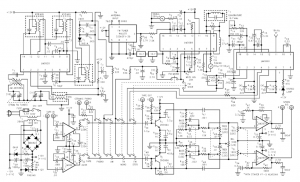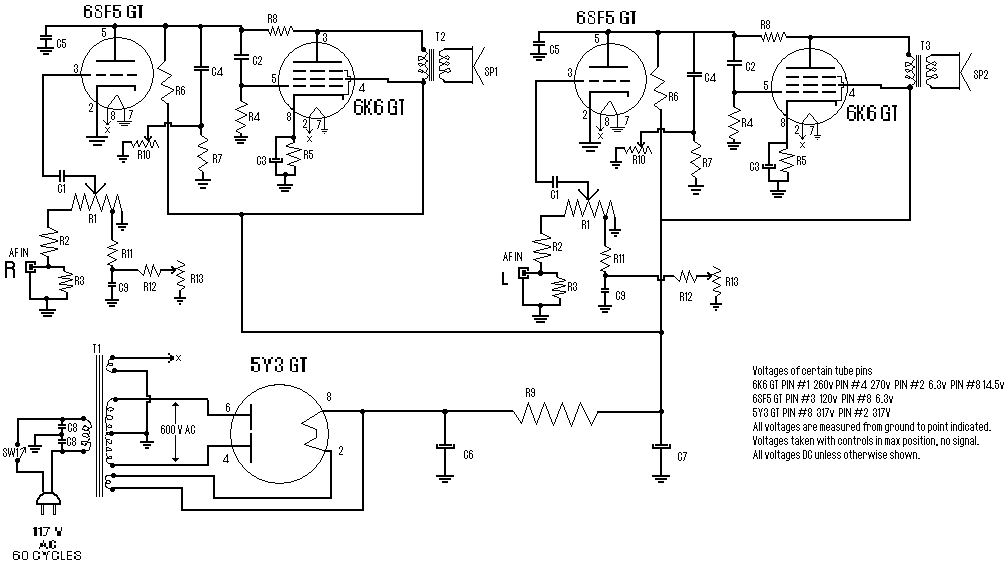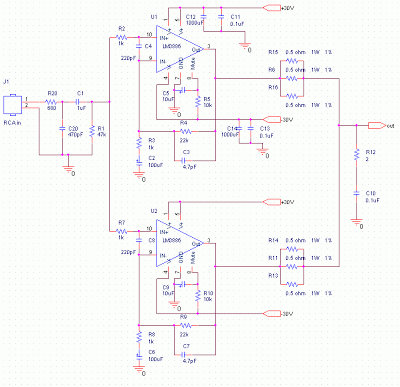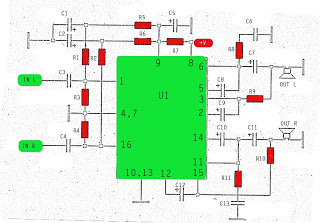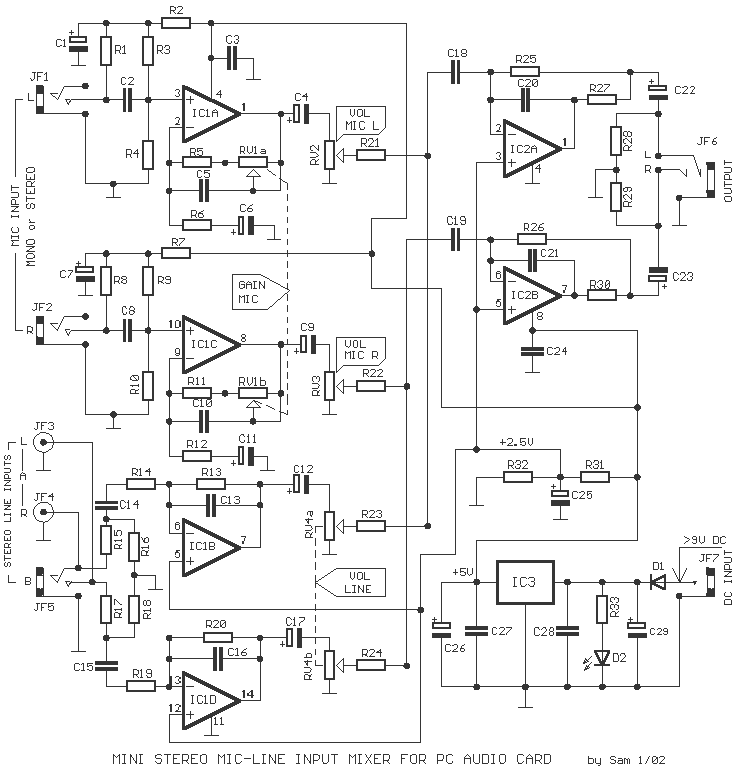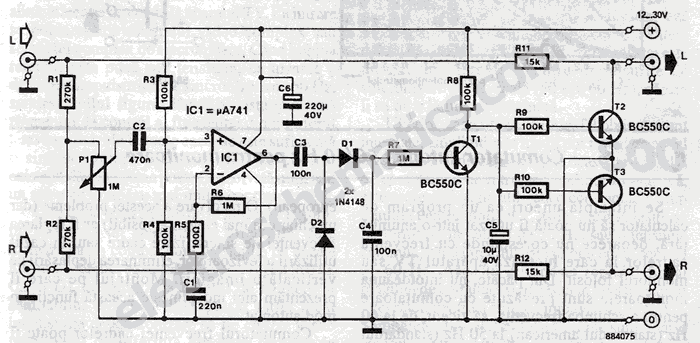
stereo
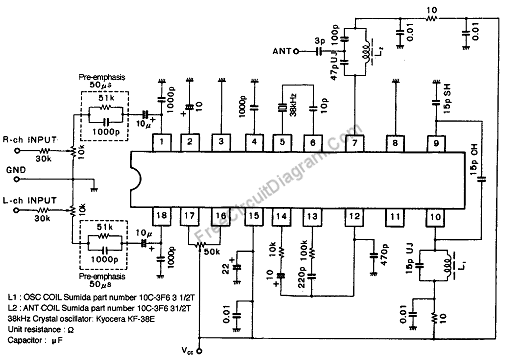
This audio amplifier design utilizes two LM3886 chips per channel in a parallel configuration, based on the PA100 parallel amplifier detailed in National Semiconductor's application note AN1192. The amplifier can deliver approximately 50W into an 8-ohm speaker and 100W into a 4-ohm speaker. As a stereo amplifier, it employs four LM3886 chips. The LM3886 circuit is configured in a non-inverting manner, with the input impedance determined by the input resistor R1, which is 47k ohms. A resistor-capacitor filter network consisting of a 680-ohm resistor and a 470pF capacitor is employed to filter high-frequency noise at the RCA input. Capacitors C4 and C8, valued at 220pF, are used to eliminate high-frequency noise at the LM3886 input pins. High-quality audio-grade capacitors are utilized in several locations: a 1uF Auricap for DC blocking at the input, 100uF Blackgate capacitors for C2 and C6, and a 1000uF Blackgate capacitor for supply filtering. The PCB is designed to separate power ground from signal ground, with the signal ground positioned centrally and surrounded by the power ground, connected by a thin trace near C5. The PCB layout is created using PADS PowerPCB 5.0, noted for its powerful capabilities. The equalizer is powered by a regulated supply, featuring 10,000uF capacitors per rail before the LT1083 regulator, followed by a 100uF capacitor on the regulator board. The use of a regulator effectively removes equalizer ripple voltage; without it, a faint 50/100Hz hum can be heard from the speaker. A high-current MUR860 diode is employed to ensure adequate current flow. The voltage regulator LT1083 can supply approximately 8A of current, and a 500VA transformer with dual 25V outputs is used. The equalizer is regulated by two LT1083 regulators, resulting in a regulated output voltage of 30V. DC measurements indicate a low 7 mV DC offset at the speaker terminal, with less than 1 mV voltage difference between the outputs of the two chips. The amplifier's sound quality is comparable to that of an LM3875 amplifier, characterized by clarity and detail, free from hum, hiss, or noise. Compared to the LM3875 Gainclone, this amplifier can deliver double the power to a 4-ohm speaker, significantly enhancing dynamics and bass response.
The audio amplifier circuit is designed for high performance and reliability, making it suitable for audiophiles seeking quality sound reproduction. The parallel configuration of the LM3886 chips allows for enhanced power output while maintaining low distortion levels. The choice of high-quality capacitors throughout the circuit ensures minimal signal degradation, contributing to the amplifier's overall audio fidelity. The careful separation of power and signal grounds in the PCB layout minimizes the risk of ground loops and electromagnetic interference, further improving sound quality.
The regulated power supply design is critical in maintaining stable voltage levels, which is essential for consistent performance, especially under varying load conditions. The use of large capacitance values before the voltage regulator allows for effective energy storage, reducing the impact of transient demands from the amplifier. The LT1083 regulator's capability to supply high current ensures that the amplifier can handle demanding audio peaks without distortion.
In summary, this audio amplifier design exemplifies a meticulous approach to achieving high-quality sound through careful component selection, thoughtful circuit design, and robust power supply management. The result is an amplifier that delivers powerful, clean, and dynamic audio performance, making it an excellent choice for both casual listeners and dedicated audio enthusiasts.This audio amplifier designed uses two LM3886 per channel, in parallel circuit, based on the PA100 parallel amplifier detailed in National Semiconductor`s application note - AN1192. This amplifier can deliver about 50W into a 8-ohm speaker and 100W into a 4-ohm speaker. This is a stereo amplifier and therefore 4 LM3886s are used. The LM3886 circui t is in a non-inverted configuration, so the input impedance is determined by the input resistor R1, i. e. 47k. The 680 ohm and 470pF resistor capacitor filter network is used to filter out the high frequency noise at the RCA input.
The 220pF C4 and C8 capacitors are used to shot out the high frequency noise at the LM3886 input pins. I used high quality audio grade capacitors at several locations: 1uF Auricap at the input for DC blocking, 100uF Blackgate for C2 and C6, and 1000uF Blackgate at the supply filter.
The PCB is designed in a way that the power ground is separated from the signal ground, as you can see from the below layout. The signal ground is located in the middle and surrounded by the power ground. There is a thin trace near C5 connecting them. The PCB layout is done by using PADS PowerPCB 5. 0. I think it is a powerful layout software. The equalizer used is a regulated power supply. I used 10000uF per rail before the LT1083 regulator. After the regulator, I have 100uF on the regulator board. The advantage of using regulator is that the equalizer ripple voltage is removed. If power regulation is not used, I can hear very little 50/100Hz hum from the speaker. The high current MUR860 diode is used to ensure high current flow. The voltage regulator used is LT1083, it can provide about 8A of current. Transformer used here is a 500VA 2x 25V. The equalizer is then regulated by 2 LT1083, after the regulation, the voltage is 30V. I did some DC measurement and the result is quite good, I got 7 mV of DC offset at the speaker terminal.
The voltage difference between the output of the 2 chips is less then 1 mV. The sound of this amplifier is similar to my LM3875 amplifier, which is very clean and detail. It has no hum, no hiss and no noise. Compared to the LM3875 Gainclone, this amp can deliver twice the power to my 4-ohm speaker, and it improves the dynamics and bass punch a lot. 🔗 External reference
The audio amplifier circuit is designed for high performance and reliability, making it suitable for audiophiles seeking quality sound reproduction. The parallel configuration of the LM3886 chips allows for enhanced power output while maintaining low distortion levels. The choice of high-quality capacitors throughout the circuit ensures minimal signal degradation, contributing to the amplifier's overall audio fidelity. The careful separation of power and signal grounds in the PCB layout minimizes the risk of ground loops and electromagnetic interference, further improving sound quality.
The regulated power supply design is critical in maintaining stable voltage levels, which is essential for consistent performance, especially under varying load conditions. The use of large capacitance values before the voltage regulator allows for effective energy storage, reducing the impact of transient demands from the amplifier. The LT1083 regulator's capability to supply high current ensures that the amplifier can handle demanding audio peaks without distortion.
In summary, this audio amplifier design exemplifies a meticulous approach to achieving high-quality sound through careful component selection, thoughtful circuit design, and robust power supply management. The result is an amplifier that delivers powerful, clean, and dynamic audio performance, making it an excellent choice for both casual listeners and dedicated audio enthusiasts.This audio amplifier designed uses two LM3886 per channel, in parallel circuit, based on the PA100 parallel amplifier detailed in National Semiconductor`s application note - AN1192. This amplifier can deliver about 50W into a 8-ohm speaker and 100W into a 4-ohm speaker. This is a stereo amplifier and therefore 4 LM3886s are used. The LM3886 circui t is in a non-inverted configuration, so the input impedance is determined by the input resistor R1, i. e. 47k. The 680 ohm and 470pF resistor capacitor filter network is used to filter out the high frequency noise at the RCA input.
The 220pF C4 and C8 capacitors are used to shot out the high frequency noise at the LM3886 input pins. I used high quality audio grade capacitors at several locations: 1uF Auricap at the input for DC blocking, 100uF Blackgate for C2 and C6, and 1000uF Blackgate at the supply filter.
The PCB is designed in a way that the power ground is separated from the signal ground, as you can see from the below layout. The signal ground is located in the middle and surrounded by the power ground. There is a thin trace near C5 connecting them. The PCB layout is done by using PADS PowerPCB 5. 0. I think it is a powerful layout software. The equalizer used is a regulated power supply. I used 10000uF per rail before the LT1083 regulator. After the regulator, I have 100uF on the regulator board. The advantage of using regulator is that the equalizer ripple voltage is removed. If power regulation is not used, I can hear very little 50/100Hz hum from the speaker. The high current MUR860 diode is used to ensure high current flow. The voltage regulator used is LT1083, it can provide about 8A of current. Transformer used here is a 500VA 2x 25V. The equalizer is then regulated by 2 LT1083, after the regulation, the voltage is 30V. I did some DC measurement and the result is quite good, I got 7 mV of DC offset at the speaker terminal.
The voltage difference between the output of the 2 chips is less then 1 mV. The sound of this amplifier is similar to my LM3875 amplifier, which is very clean and detail. It has no hum, no hiss and no noise. Compared to the LM3875 Gainclone, this amp can deliver twice the power to my 4-ohm speaker, and it improves the dynamics and bass punch a lot. 🔗 External reference
